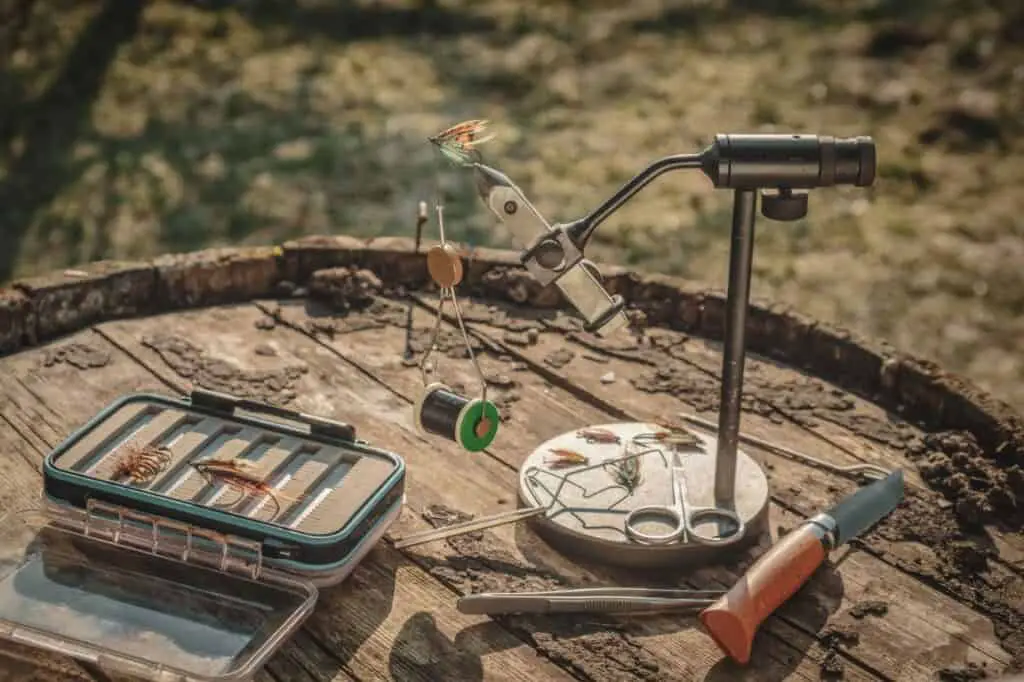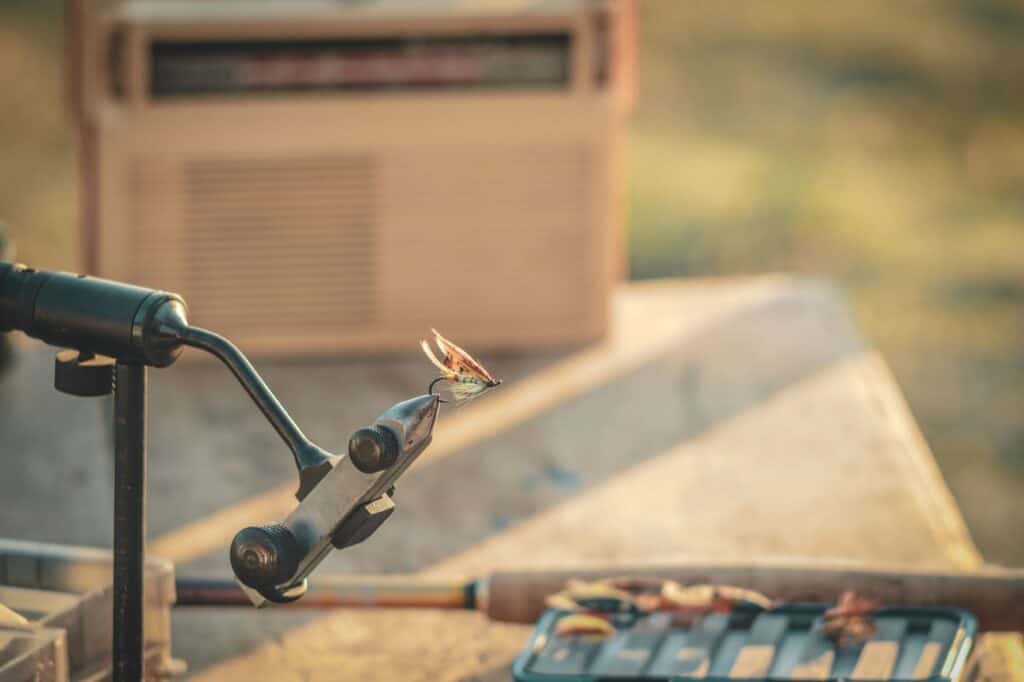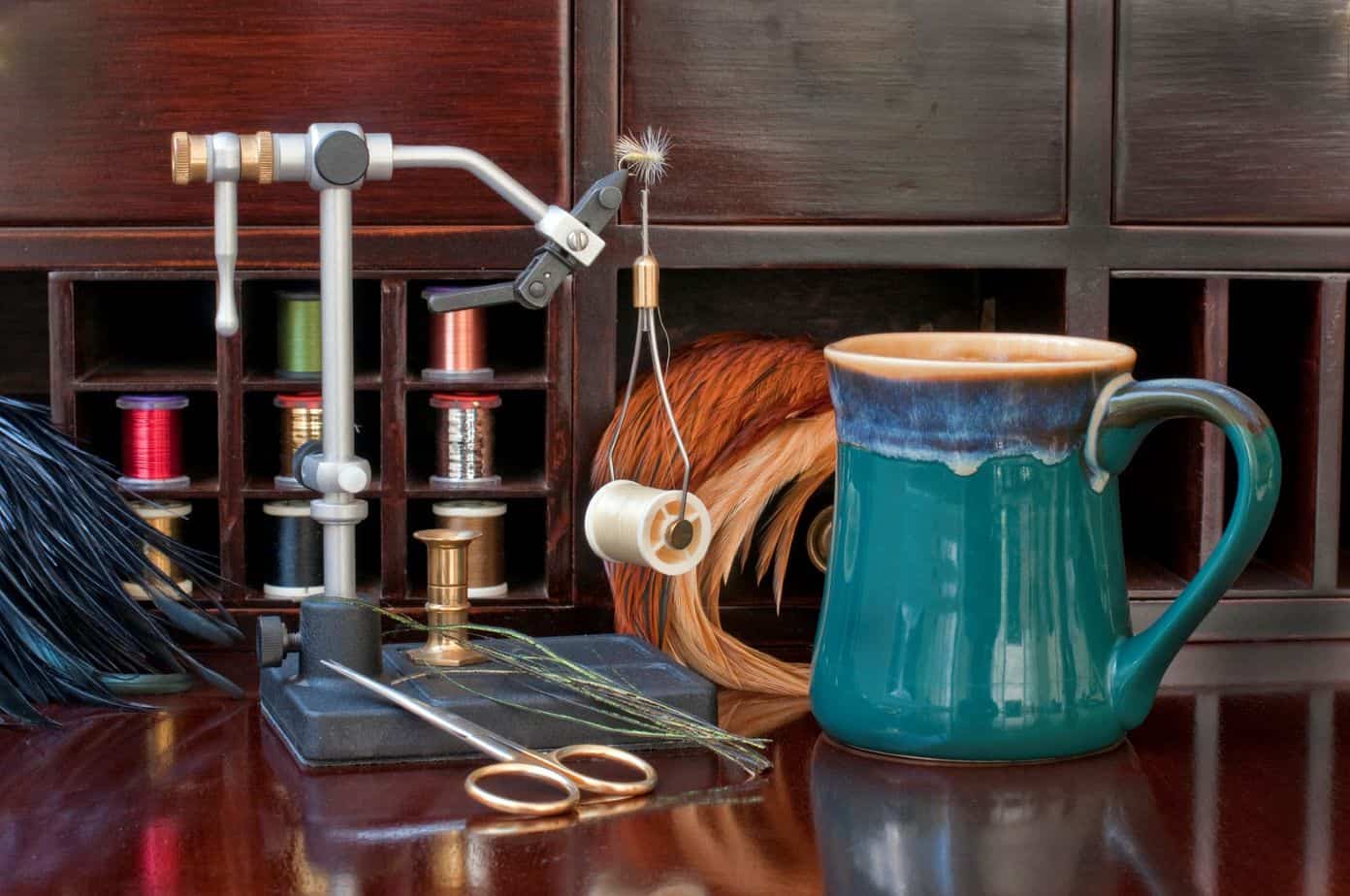At some point along your fly fishing journey, the idea of tying your own flies will probably come to mind. However, tying flies is nearly impossible without a fly tying kit on hand. These give you everything you need to save money and construct high-quality flies.
The best beginner fly tying kits need to have high-quality features such as scissors, a bodkin, whip finisher, and much more. The best ones on the market are easy to buy and simple to use so beginning anglers can get their start. Plus, they should be affordable and reliable in the long term. Here are the best beginners fly tying kits on the market.
No matter what type of fly fishing you are doing, there are fly tying kits catered to your needs. Even once you are no longer classified as a “beginner,” these kits will last a lifetime and always be there for you. However, without the proper knowledge, it will be hard to find the right kit for you.
Best Fly Tying Kits for Beginners
Although the market has many fly tying kits, a few cater to beginners and deliver incredible value for the price. The key is finding one that hits your field of fly fishing while also giving you immense value. Here are our top picks for beginning fly tying kits.
And if you need to learn more about the different types of flies for fly fishing, read “Different Types of Fly Fishing Flies.”
Orvis Premium Fly Tying Kit

One of the oldest and most respected names in the fly fishing industry is Orvis. They make everything from reels to rods to tons of accessories. They also make a fantastic beginning fly tying kit.
From the moment the kit is opened, you will know that the quality is there. All of the necessary tools are arranged professionally and sets you up with a lifelong kit. This is precisely what you want in a tying kit. You need something that exudes quality and will last a lifetime.
All of the necessary tools are included. This means you will have high-quality scissors, a bobbin, a bodkin, pliers, a whip finish tool, and more. All of these sit nicely in a hard carrying case that is included with the package. This is a huge perk because it makes it very easy to take on the go.
This kit provides you with a total of 160 flies with the given materials. This is good because you want a kit that won’t be worked through right away. There are 16 patterns so that you can have ten flies each. This allows you to branch out of your comfort zone and try some patterns that you may not buy yourself.
Some of the patterns of the Orvis kit include:
- Wooly bugger
- Elk hair caddis
- Chernobyl ant
- San Juan worm
- Zebra Midge
- Lightning bug
The main downside of the Orvis kit is its price. It can be fairly costly, especially for beginners. So, if you have some extra money to spare, you will see the value once the kit is in your hands.
Orvis makes it super easy for beginners, but they also do a great job of creating a lifelong kit, even for the most experienced angler. This is the perfect kit if you have long term plans tying flies. Especially at this price point, you need something that can last a long time. You will probably like it so much that it will become your go-to kit when you’re more experienced.

Scientific Anglers Fly Tying Kit

Like Orvis, Scientific Anglers is another brand with its hands dipped into various fly fishing markets. This kit gives you a broad range of options so that you can practice tying nymphs, streamers, and the traditional dry flies. This is a huge perk because knowing how to tie any type of fly for any situation is huge.
There are pliers, a vise, a bobbin threader, a hair stacker, and more in the kit. It is comprehensive enough to get you by, but it is missing a couple of materials included in other options. For example, there is no whip finish tool or wax included. They also include only one color of thread, so you’ll have to do some outside shopping if you need more.
Luckily, this is one of the most affordable kits on this list for what you get. Sure, some of the tools you could need aren’t included, but they aren’t overpricing the product. It also comes with a nice carrying case so you can do work on the go.
Some fly tying kits can overcomplicate the process by having a ton of moving parts and make it all overwhelming. This is not the case with the Scientific Anglers kit. They make it all super simple, so if it is your first time tying flies, this is a valuable option. Obviously, this list is one for beginners, but some kits can be more complicated than others.
This does not give you as many options as the Orvis kit, but there are definitely enough to get started. Some of the materials include:
- Elk hair
- Pheasant tail
- Peacock herl
- Copper wire
- Chenille
This isn’t the most you can have, but it does cover many of the bases involved with fly fishing. So, keep the Scientific Anglers Beginner kit in mind.
Dr. Fish Fly Tying Kit

If the budget allows, buying a beginner kit that is all-encompassing and has better quality items is best. However, not everyone can do this, so it is important to have options for all budgets. Like the Orvis fly tying kit, the Dr. Fish kit is on the higher end of the beginner price spectrum.
This is the perfect option if you like to do it right and don’t mind spending some extra cash. Plus, the kit is so good that you can spend years crafting flies out of this kit without needing to upgrade.
All of the necessary tools needed to tie quality flies are included. This includes a bodkin, whip finisher, scissors, bobbin holder, and even more. These are the mainstays of fly tying, so you can get an excellent grasp of the process without buying any additional tools.
Every good kit should have a vise included. The better the quality of the vise, the easier the tying is. Dr. Fish’s vise is all aluminum and super strong.
There are 55 total hooks in three sizes so that you can make a good number of flies right away. Some of the materials included are elk hair, hackle for dry flies, hare mask, peacock herl, pheasant tail, and even more. This gives you a broad range of potential fly options.
In this case, there is no instructional video or pamphlet included in particular, so you will have to rely on the internet for help, which should be no problem for most people.
Wetfly Deluxe Fly Tying Kit

If you are interested in tying flies but you are hesitant to make the full financial equipment, the WETFLY Deluxe fly tying kit can do the job. This is because it does not have the best materials and most sturdy equipment, but it can definitely get the job done.
Even if you are looking for a kit that will last a long time, but you won’t be obsessively tying flies, this is a fantastic option. That being said, there are 48 hooks over three sizes to kickstart your tying journey.
If you still have a DVD player in this all-digital age, there is a great DVD included that is instructional and super helpful to get started. But, who knows how much that is actually worth given how much information is out on the internet for free.
In the kit, along with the DVD, there is yarn, copper and black thread, scissors, a vice, and many other main tools required for fly tying. There is a decent carrying case included, so you can practice tying when out on business or simply out of the house.
This kit hammers home the ability to construct nymphs. Wet fly fishing is very popular and can be quite rewarding. So, a lot of the physical materials are catered toward streamers and nymphs. This includes rabbit dubbing, marabou, hackle, elk hair, and chenille.
Especially at the current price point, the WETFLY kit is an excellent kick starter for beginning tiers that may want to keep it casual or already have plans to upgrade to some high-end setups once their budget improves.
Colorado Anglers Wooden Fly Tying Kit

- Click HERE to check the current price on Amazon.
- Click HERE to check the current price on TridentFlyFishing.com.
To round out our list, we have the Colorado Anglers Wooden Fly tying kit. This kit is slightly different in the simple sense that there is a hand-crafted wooden box that contains the kit. The others on this list have more travel and composite carrying cases, but this kit takes a more “home base” approach.
Instead of building your flies on the go, this kit is made to become a permanent part of your shop or where you do your work. Sure, you can throw it in your bag and get on the road, but a lot of the other options are catered to that as well.
That being said, it is what is in the box that matters. So, let’s break down some of the kit’s contents. There is the obligatory vise, scissors, bodkin, whip finisher, and many other required tools. Thankfully, there is enough included that you shouldn’t have to buy additional tools unless you want to upgrade.
In terms of materials for the flies themselves, there are three sizes of hooks. This is relatively common and seen in the rest of the kits on this list. They come in 8, 12, and 14. These are also the standard sizes that come in a majority of kits.
You also get two colors of wire, elk hair, peacock herl, head cement, chenille, hackle, and more. You can experiment and make several different flies with this kit. Plus, they throw in a tying book and DVD. If you don’t know what you are doing, like most beginners, you can resort to the materials and learn a lot.

Is Tying Your Own Flies Cheaper Than Buying Them?
Tying your own flies requires significant investments in tools, materials, and time, so it is only worth it when tying so many flies that you make that money back.
Determining whether or not tying your flies is worth it is a worthwhile conversation to have. Fly tying kits are great, but they are pointless if you decide to buy the flies at a shop anyway.
Tying your own flies comes at a cost. You have to pay for a tying kit that includes the necessary tools and a kick starting number of materials. You can buy them all separately, but this may end up costing you more money.
So, the first factor to consider is how much those tools and materials will be. For a starting kit, the average is around $100 for an all-encompassing kit that gives you enough materials to get started. You have to factor in all of the additional materials because there is only so much included the first time around.
The price of pre-tied flies varies depending on the pattern and the quality, but you can generally spend between $1-5 on a fly. They can get far more expensive, but that is for the high-end angler.
Now, you may be able to make a fly for 50 cents worth of materials, but it isn’t that simple. When buying materials, you are buying in bulk. So, your initial investment may seem high. Once you do the math for your specific materials, you will probably find that it will take hundreds of flies before you get your money’s worth.
For example, you may have to tie your 250th fly before actually saving any money. So, if you are the casual angler who will never see that many flies in your lifetime, tying flies would not be worth the money. Stick with stopping by the local fly shop.
If you want to create a big bulk of flies, this is perfect. You can customize the flies to your exact specifications while also gaining more knowledge about the sport. If you can reasonably see yourself using or selling hundreds of flies, this is the way to go.
What Is The Easiest Fly To Tie?
Tying flies is a learning curve that many fly anglers do not even consider trying to master. But, for those who do, there has to be a starting point. The Pheasant Tail Nymph is one of the easiest flies to start tying.
There are so many fly patterns, shapes, and sizes out there. To determine what flies you should begin crafting, you need to keep it simple and use techniques that are easy to learn. Flies can get super complicated and challenging for even the most advanced tiers.
So, a great starting point is the Pheasant Tail Nymph fly. This isn’t your traditional dry fly, but nymphing is super popular, especially for trout. To learn more about nymphing, see another blog here.
The Pheasant Tail Nymph is one of the biggest mayfly imitators out there. So, it will work in many areas across the world. It is really easy to tie because it uses basic, natural materials without too many moving parts. After a few times working it out, this pattern will become second nature to you.
Another starter fly should be the elk hair caddis. Elk hair can be found in almost any fly-tying kit there is. So, it is only natural that you learn to use that material. This is also one of the most popular dry flies globally because of its versatile pattern.
Like so many other anglers, if you fall in love with the elk hair caddis fly, you will surely go through many of them. This is yet another perk of knowing how to tie them yourself.
Conclusion
Having a fly fishing kit to help you jump into tying flies is the best way to be introduced to the craft. Without it, it can be hard to gather the necessary materials, learn about the art, and get an overall sense of tying flies.
The above beginner fly tying kits are catered to those who want to jump into tying without any significant issues. If this is you, we strongly urge you to pick one of the above kits and try it out for yourself!
If you are new to fly fishing, click here to see all over our other awesome content about the sport! There is so much to learn about various aspects of the fly fishing industry.


